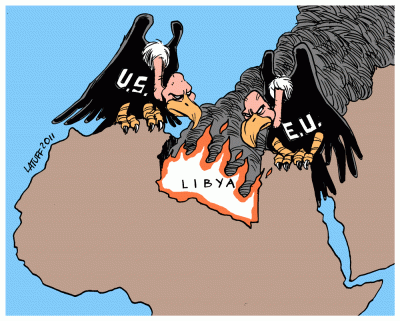The Reason Why NATO Demolished Libya Ten Years Ago

All Global Research articles can be read in 27 languages by activating the “Translate Website” drop down menu on the top banner of our home page (Desktop version).
***
Ten years ago, on March 19, 2011, US / NATO forces began the air-naval bombing of Libya. The war was directed by the United States, first through the Africa Command, then through NATO under US command. In seven months, the US / NATO air force carried out 30,000 missions, 10,000 were attack missions, with over 40,000 bombs and missiles. Italy – with Parliament multipartisan consent (Democratic Party in the front row) – participated in the war with seven air bases (Trapani, Pantelleria (Sicily), Gioia del Colle, Amendola (Puglia) Decimomannu (Sardenia), Aviano (Veneto), and with Tornado fighter-bombers, Eurofighters and others, as well as the Garibaldi aircraft carrier and other warships. Even before the air- naval offensive, tribal sectors, and Islamic groups hostile to the government had been financed and armed in Libya, and special forces, particularly Qatari, had infiltrated to ignite armed clashes inside the country.
In this way, the African State was demolished. As the World Bank documented in 2010, it maintained “high levels of economic growth” with an increase in GDP of 7.5% per year, and recorded “high indicators of human development” including universal access to primary and secondary education schools and, over 40%, to university education. Despite the disparities, the average standard of living in Libya was higher than in other African countries. About two million immigrants, mostly Africans, found work there. The Libyan State, which possessed the largest oil reserves in Africa plus other natural gas reserves, left limited profit margins to foreign companies. Thanks to energy exports, the Libyan trade balance was in surplus of 27 billion dollars a year. With these resources, the Libyan State had invested about 150 billion dollars abroad. Libyan investments in Africa were crucial to the African Union’s plan to create three financial organizations: the African Monetary Fund, based in Yaoundé (Cameroon); the African Central Bank, based in Abuja (Nigeria); the African Investment Bank, based in Tripoli. These bodies would serve to create a common market and a single currency for Africa.
It is no coincidence that NATO’s war for the demolition of the Libyan State began less than two months after the African Union Summit, on January 31, 2011, which started the creation of the African Monetary Fund to be realized within the year. This is proven by emails from the Obama administration’s Secretary of State, Hillary Clinton, brought to light later by WikiLeaks: United States and France wanted to eliminate Gaddafi before he used Libya’s gold reserves to create a pan-African currency, alternative to the dollar and the CFA franc (currency imposed by France on its 14 former colonies). This is proven by the fact that, before the bombers went into action in 2011, the banks went into action: they seized the 150 billion dollars invested abroad by the Libyan State, most of which disappeared. In the great robbery, Goldman Sachs, the most powerful US investment bank of which Mario Draghi had been vice president, stood out.
Today, the revenues from energy exports in Libya are being captured by power groups and multinationals in a chaotic situation of armed clashes. The living standard of the majority of the population has collapsed. African immigrants, accused of being “Gaddafi’s mercenaries,” were even imprisoned in zoo cages, tortured, and murdered. Libya has become the main transit route of a chaotic migratory flow to Europe in the hands of human traffickers that has caused many more victims than the 2011 war. In Tawergha the Misrata Islamic militias supported by NATO (those who assassinated Gaddafi in October 2011) carried out a true ethnic cleansing, forcing almost 50,000 Libyan citizens to flee without being able to return. The Italian Parliament, who was also responsible for all this, on March 18, 2011, committed the Government to “take every initiative (ie Italy’s entry into the war against Libya) to ensure the protection of the populations in the region.”
*
Note to readers: please click the share buttons above or below. Forward this article to your email lists. Crosspost on your blog site, internet forums. etc.
This article was originally published in Italian on Il Manifesto.
Manlio Dinucci is a Research Associate of the Centre for Research on Globalization.

